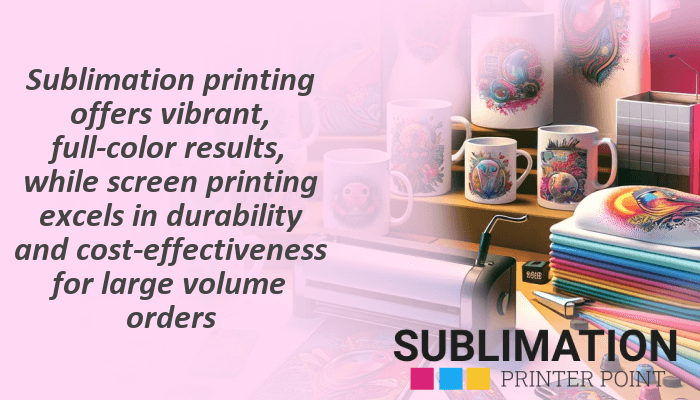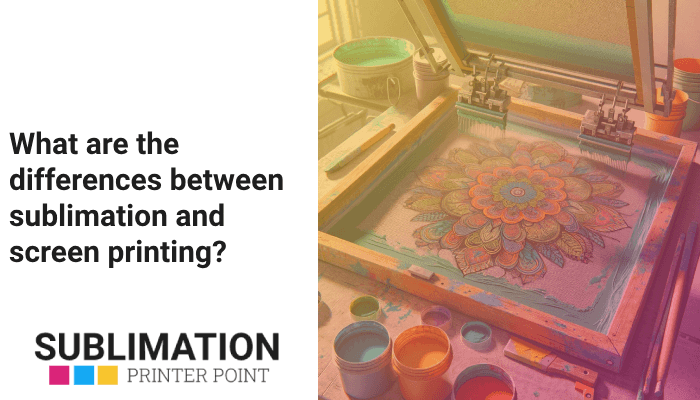In this text, we will examine and compare two widely used printing techniques such as screen printing and sublimation printing. We will delve into their different applications, processes and key differences that set them apart.
Using heat to transfer dye to surfaces, sublimation is a digital printing technique that creates vibrant, full-color images. Polyester fabrics and hard substrates coated with a unique polymer layer work well with it. The classic screen printing method involves pushing ink onto the printing surface through a mesh stencil. It is known for its durability and ability to create vibrant colors, especially on dark textiles. The specific requirements of the project will determine which of these two options is best.
- Sublimation printing is a heat transfer method producing vibrant, full-color images.
- Screen printing pushes ink through a mesh stencil, producing durable and vivid prints.
- Sublimation is ideal for polyester fabric and hard substrates with a special polymer layer.
- Screen printing works well with a wide range of fabrics, including cotton and blends.
- The choice between sublimation and screen printing depends on the project’s specific requirements.
| Printing Method | Advantages | Disadvantages | Best Used For |
|---|---|---|---|
| Sublimation Printing | Full-color, complex designs, smooth color transition, highly durable prints, quick turnaround time | Not suitable for natural fibers like cotton, requires special ink and paper, colors may appear slightly different on the substrate | Polyester fabric and hard substrates, items like mugs, mouse pads, and sportswear |
| Screen Printing | Bright, vivid colors, highly durable, cost-effective for large orders, versatile for different fabrics | Requires more setup time, costly for designs with multiple colors, not ideal for complex, multi-colored designs | Wide range of fabrics, including cotton and blends, t-shirt printing, items that require high-quality, long-lasting prints |
This table compares screen printing versus sublimation printing, emphasizing the benefits, drawbacks, and ideal applications for each.
What is the basic understanding of sublimation and screen printing?
Screen printing and sublimation are two different printing techniques, each with special qualities and uses. The printing industry uses both screen printing and sublimation printing techniques, although their processes, results, and appropriate applications are very different. The decision between screen printing and sublimation is frequently influenced by the particulars of the project, such as the kind of cloth, the intricacy of the design, and the volume of orders. Making wise selections in a variety of printing settings requires an understanding of these two printing techniques.
What is sublimation printing?
A digital printing technique called sublimation printing transfers dye onto materials like card, cloth, and plastic by using heat. ‘Sublimation’ refers to the process of changing the dye from a solid to a gaseous form without going through the liquid state. The potential of this printing method to create vivid, full-color images with smooth color transitions is well known. It is perfect for products like mouse pads, mugs, and sportswear since it is frequently used for printing on polyester fabric and hard surfaces coated with a unique polymer layer.
What is screen printing?
In contrast, screen printing is a conventional printing technique where ink is applied to the printing surface by pushing it through a mesh stencil. This approach works well for designs with a small color palette because each color in the design needs its own screen. Screen printing is renowned for its robustness and capacity to generate vibrant, bright colors—even on darker textiles. It is frequently used for printing posters, t-shirts, and other objects that need to be printed on using durable, high-quality ink.
Were you aware that sublimation printing relies heavily on the International Color Consortium (ICC) profiles? They guarantee that the colors in your computer design and the printed item are same. Using ICC profiles is advised by Pro World for accurate color reproduction.
How does the process of sublimation and screen printing work?
Both screen printing and sublimation are complex procedures that need both accuracy and knowledge. Although screen printing methods and the sublimation printing process can appear complicated at first, knowing them will help you better appreciate their benefits and drawbacks. Let’s examine the operation of each of these printing techniques.
How does sublimation printing work?
Using a program like Adobe Photoshop or Sawgrass Creative Studio, a digital design is created before the sublimation printing process begins. Sublimation ink is then used to print the pattern onto a unique sublimation paper. After placing the printed sheet onto the substrate, heat is applied, usually between 350 and 400 degrees. The ink sublimates and penetrates the substrate because to the heat, producing a vivid, long-lasting print that won’t fade or shatter.
How does screen printing work?
The first step in screen printing is to make a stencil, or screen, for each color in the design. A photographic emulsion is applied on the screens, and a strong light is used to burn the design into the emulsion. After that, the screens are put on the printing surface, and ink is applied to the cloth by pushing it through the stencil. To guarantee longevity, the print is dried after all colors have been applied. Although screen printing is more expensive for large orders, it requires more setup time than sublimation.
What are the key differences between sublimation and screen printing?
Although screen printing and sublimation are both widely used printing techniques, there are some significant differences between them, such as print quality, color separation, and compatibility for various fabrics and t-shirt printing. Knowing these distinctions can assist you in selecting the best approach for your particular requirements.
Advice: Using premium inks when screen printing can greatly enhance the print quality. Experts highly recommend brands like Oracal 651 and Speedball. For your convenience, Amazon also provides a large selection of screen printing inks along with user reviews to aid in decision-making.
What are the differences in print quality?
The capacity of sublimation printing to create vivid, full-color prints with a seamless color transition is well known. Due to the ink’s incorporation into the substrate, the prints are also incredibly durable. In contrast, screen printing creates brilliant, bright colors, especially on darker textiles. However, elements like the kind of ink used and the accuracy of the screen alignment might have an impact on the print quality.
How do the techniques differ in color separation?
When using sublimation printing, color separation is not too difficult because the design is produced in full color onto the sublimation paper. When screen printing, every color needs its own screen, which may be expensive and time-consuming for patterns with a lot of colors. On the other hand, because screen printing applies each color separately, it can achieve higher color accuracy.
What are the differences in the use of fabric and t-shirts printing?
The optimum materials for sublimation printing are polyester fabric and rigid surfaces covered in a unique polymer coating. Natural fibers like cotton are not suited for it because they lack the polymers that the ink needs to bond with. Screen printing is a popular option for printing t-shirts since it is compatible with a variety of textiles, including mixes and cotton.
What are the pros and cons of sublimation and screen printing?
Sublimation and screen printing both have benefits and drawbacks, just like any other printing technique. These benefits and drawbacks might have a big impact on the printing process selection, depending on the project’s particular needs.
What are the advantages of sublimation printing?
One of the many benefits of sublimation printing is its ability to produce intricate, full-color graphics with seamless color transitions. In addition, the prints have exceptional durability and resist fading over time. Furthermore, because sublimation printing doesn’t need the setup time needed for screen printing, it may be completed quickly.
What are the disadvantages of sublimation printing?
Sublimation printing has benefits, but it also has certain drawbacks. Natural fibers like cotton are not suited for it, and the substrate’s quality may have an impact on the print quality. Special paper and ink are also needed for sublimation printing, which raises the price. Additionally, the colors on the substrate might not seem exactly the same as they do in the digital design.
What are the advantages of screen printing?
Bright, vivid colors can be produced with screen printing, even on darker textiles. In addition, it is incredibly resilient and won’t fade even after several washings. For large orders, screen printing is economical because the cost per unit goes down as the quantity increases. It is also adaptable and works with a variety of textiles.
What are the disadvantages of screen printing?
Unfortunately, because screen printing needs separate screens for each color, it can be more expensive and require more setup time for designs with numerous colors. In addition, elements like the kind of ink used and the accuracy of the screen alignment might have an impact on the print quality. Furthermore, because of its limitations in color separation, screen printing is not the best option for intricate, multicolored designs.

Which printing method is better for different applications?
The particular needs of the project will determine whether sublimation or screen printing is the preferred option. The type of fabric, the intricacy of the design, and the volume of orders are just a few examples of the variables that can affect the printing process selection.
When is sublimation printing a better choice?
When printing intricate full-color designs with seamless color transitions, sublimation printing is a superior option. Additionally, because it doesn’t require the setup time associated with screen printing, it’s perfect for small to medium-sized orders. For things like mouse pads, mugs, and sportswear, sublimation printing works best on polyester fabric and rigid substrates coated with a unique polymer layer.
When is screen printing a better choice?
When printing on a variety of materials, such as cotton and mixes, screen printing is a preferable option. Large orders are also a good fit because the price per unit goes down as the quantity increases. Screen printing is a popular option for printing t-shirts and other things that need high-quality, long-lasting designs because it generates brilliant, vivid colors, especially on darker textiles.

